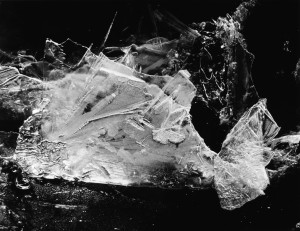 Sometimes I work with a particular project in mind. I’ve already decided on the subject matter and perhaps the print statement: process, materials, toning, inkset, etc. Stones and Organics were conceptualized as abstract landscapes printed in silver gelatin using a particular developer and paper and toned with selenium. Movement was conceptualized as abstract landscapes printed on matte paper using an inkjet printer.
Sometimes I work with a particular project in mind. I’ve already decided on the subject matter and perhaps the print statement: process, materials, toning, inkset, etc. Stones and Organics were conceptualized as abstract landscapes printed in silver gelatin using a particular developer and paper and toned with selenium. Movement was conceptualized as abstract landscapes printed on matte paper using an inkjet printer.
 Other times a project will result from looking at images I have already taken and building on that idea. I collected the Wheatpaste Graffiti images during several trips to New YorkCity and Brooklyn. I printed them on several types of digital media and finally settled on large canvas prints. The scale and the texture just seemed to express the feeling I had in mind.
Other times a project will result from looking at images I have already taken and building on that idea. I collected the Wheatpaste Graffiti images during several trips to New YorkCity and Brooklyn. I printed them on several types of digital media and finally settled on large canvas prints. The scale and the texture just seemed to express the feeling I had in mind.
I love to experiment and I print in several processes: silver gelatin, platinum/palladium, salted paper, kallitype, photopolymer gravure, and inkjet. I knew I wanted to print Thin Ice in silver gelatin, but I experimented with five developer formulas on several papers in order to find the right black for the images. Many times a project will materialize based on a print statement I am working on. I was experimenting with creating an antique look on one of the new baryta glossy inkjet papers and images I had collected during several trips to France found a vision. I experimented with the Cross Country 2010 images trying to give them an illustrative, surreal feel. When I was asked to show some recent images in applying for the Winslow Homer project at the Portland Museum of Art, I printed them in salted paper and toned them in gold. That led to the print statement for the Homer project.
I started out processing film and printing in a traditional darkroom. Now I capture images digitally, edit them in Lightroom and Photoshop, and either print them on an inkjet printer, make digital negatives and print them in a traditional darkroom, or make digital positives and make plates for printing on an etching press. I’ve developed a few techniques that are specific to Photoshop, but for the most part, I use the same techniques digitally that I practiced in the traditional darkroom: contrast control and local burning and dodging. The nice thing about Photoshop is that you can do it more precisely and the results are easily repeatable. .
